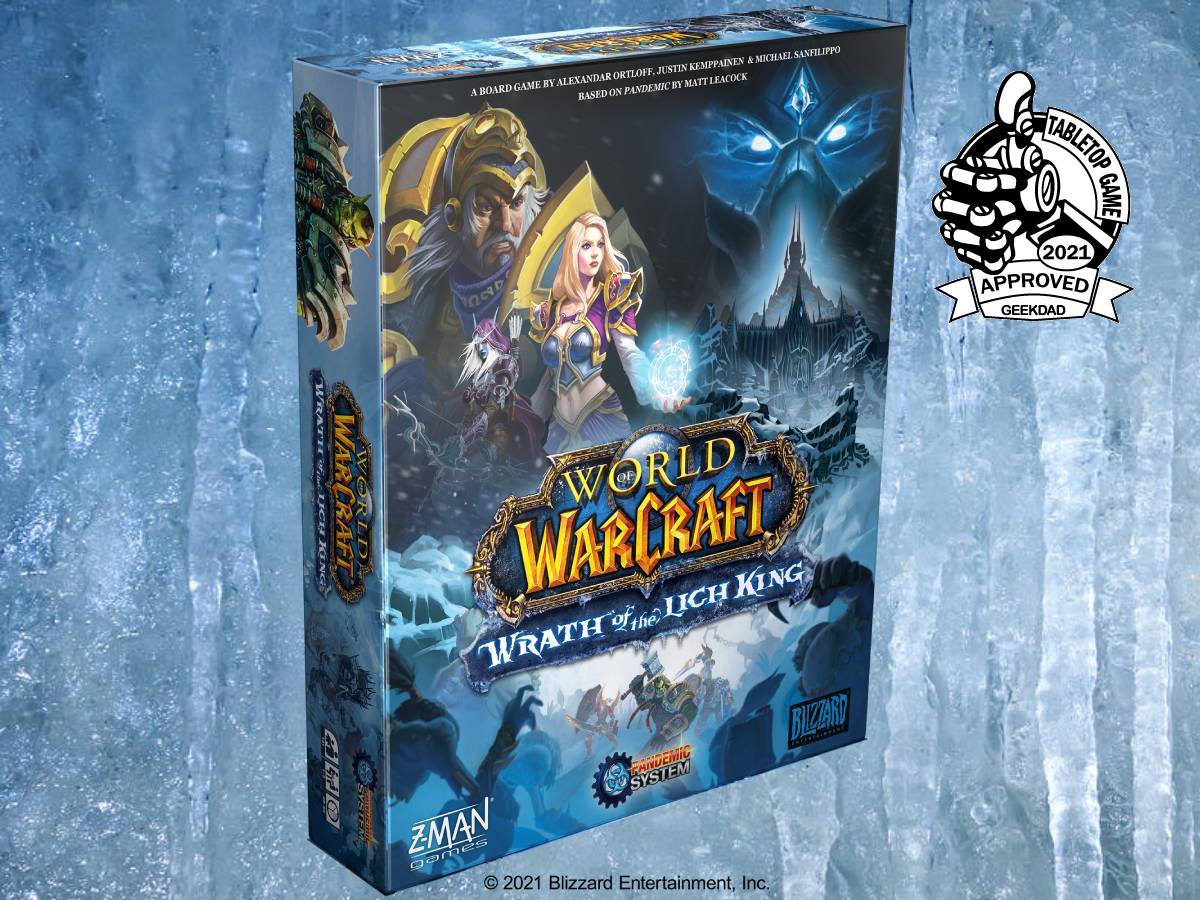The armies of the Lich King are on the march, and the heroes of both The Horde and The Alliance must brave the frozen reaches of Northrend to fight this menace. Can you complete your quests to defeat the Lich King before he conquers Azeroth?
What Is World of Warcraft: Wrath of the Lich King – A Pandemic System Game?
World of Warcraft: Wrath of the Lich King – A Pandemic System Game is a cooperative game for 1- 5 players, ages 15 and up, and takes about 45-60 minutes to play. The game combines the long-running Blizzard Entertainment MMO World of Warcraft with the Pandemic game system. It retails for $59.99, and is currently available exclusively at Target until November, when it will go into wide release at other stores. You can also preorder a copy directly from Asmodee.
World of Warcraft: Wrath of the Lich King – A Pandemic System Game was designed by Alexandar Ortloff, Justin Kemppainen, and Michael Sanfilippo, and published by Z-Man Games and Asmodee, with illustrations by Atha Kanaani. It also has one of the longest game titles that I have ever seen.

World of Warcraft: Wrath of the Lich King – A Pandemic System Game Components
The box contains the following:
- 7 Heroes
- 36 Ghouls
- 3 Abominations
- 1 Lich King
- 2 Dice
- 5 Sliders
- 1 Game Board
- 7 Hero Sheets
- 10 Quest Sheets
- 63 Hero Cards
- 9 Reward Cards
- 30 Scourge Cards
- 5 Reference Cards
- 3 Quest Markers
- 1 Scourge Marker
- 1 Despair Marker
- 3 Quest Progress Markers
- 1 Solo Marker
- 3 Strongholds
- 1 Icecrown Citadel

The game board manages to both be one of the more graphically interesting boards for a Pandemic game, yet also one of the best laid out. True to its lineage, there’s a lovingly illustrated map of Northrend that will be instantly familiar to any fan of World of Warcraft. The underlying map doesn’t distract from what’s going on game-wise, however. The map is divided into 3 different regions, all distinctly color coded both for their locations and for where each region’s quest cards will sit. Icecrown Citadel has its own discrete location on the map, sized perfectly for the 3-dimensional cardboard Citadel that will sit in that location.
The Scourge track, which increases the difficulty of the game over time, and the Despair track, which acts a doom timer, are both discretely located, and have their own matching tokens to track progress. And while there are not room for the Hero cards or Scourge cards on the board itself(largely due to the large Quest Sheets), there are graphical indicators on where to place the corresponding decks and discard piles adjacent to the board. Finally, Icecrown Citadel has its own discrete location on the map, sized perfectly for the 3-dimensional cardboard Citadel that will sit in that location.

The Icecrown Citadel model manages to combine a fairly simple assembly along with strong graphical elements to create a striking piece that adds some looming threat to the board, alongside the larger miniature of the Lich King himself.

The miniatures in World of Warcraft: Wrath of the Lich King – A Pandemic System Game are all quite nice, and evocative of their counterparts from the World of Warcraft MMO. Instead of the “disease cubes” from the original Pandemic game, there are dozens of tiny Ghouls. I appreciated that the Ghouls came in a few different poses, rather than all being exactly identical. And again, if you’re familiar with the MMO, then these little buggers will be instantly identifiable, despite their miniscule size.
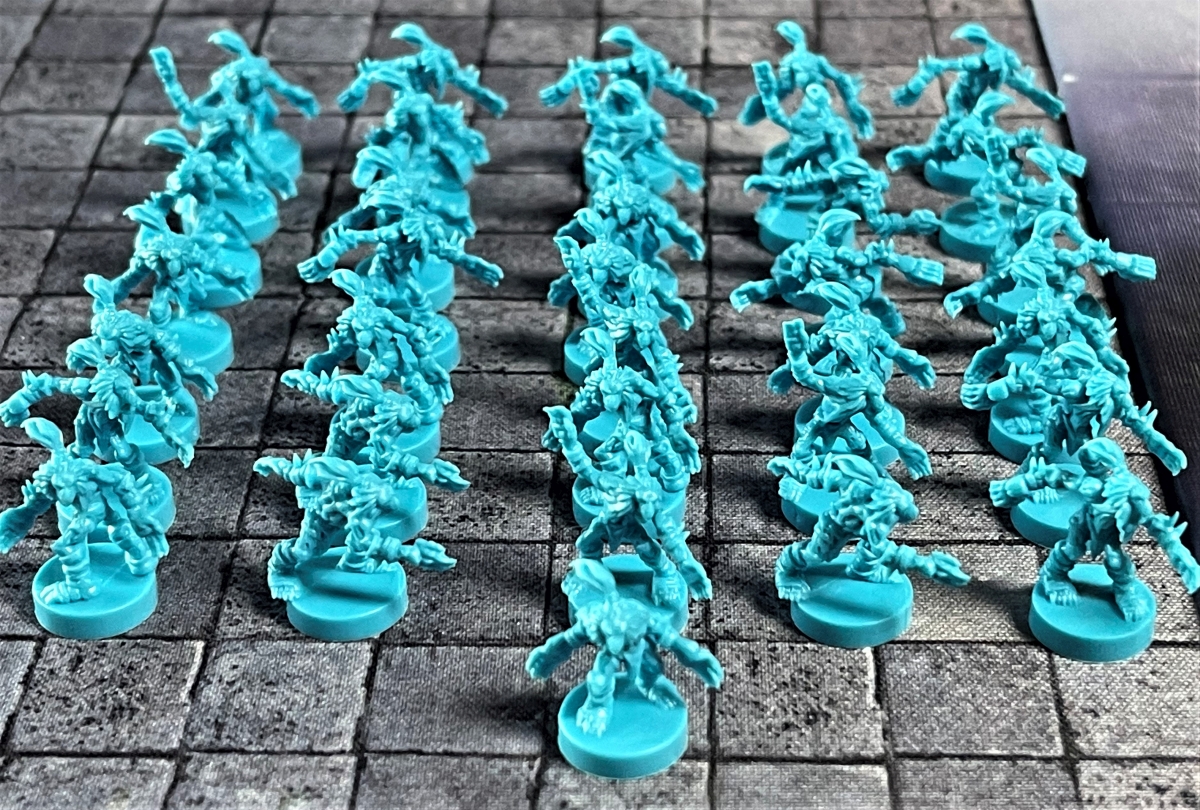
Rounding out things on the bad guys’ side, you get 3 Abominations. These are almost as big as the Lich King, and again look like they leapt straight out of the video game.

There are 7 different Heroes to choose from in the game. Each of them has a couple of unique special abilities, as shown on their Hero sheet. These are usually an action, and a passive ability. The sheet, which is printed on card, also has a health track; different heroes will start with a different amount of health. And not that it matters for gameplay, but each Hero also has the symbol of their faction in the upper left corner, so you know whether they belong to the Alliance, the Horde, or the Argent Crusade.

On the other side of each Hero sheet, you’ll find a bit of history on each character, as well as where the character starts on the game board, and a picture of their miniature. The latter two are especially useful, as the piece of the map reproduced on the Hero sheet allows for quick placement of the miniature during setup. Having a picture of the actual miniature erases any possible confusion as to which miniature is which.

And much like the other miniatures, the Hero miniatures themselves are nicely detailed for their size, and accurate to their appearances in World of Warcraft.
World of Warcraft: Wrath of the Lich King – A Pandemic System Game also comes with two custom dice. You’ll use these dice when in combat(the main way of removing ghouls and abominations from the board) and progressing in quests.
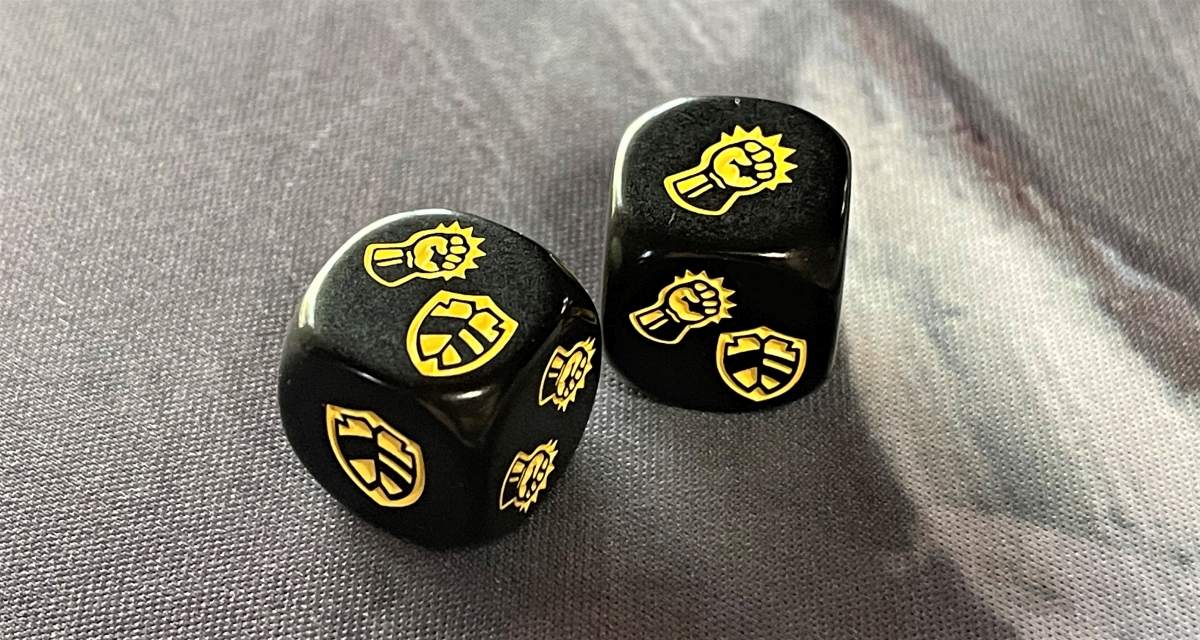
The oversized Quest Sheets have a track which you will move a torch-emblazoned token along as you make progress. There are 3 different Quest Sheets for each of the 3 regions in the game, as well as one for Icecrown Citadel. Many quests have a special effect, as well as a number which indicates the amount of damage you take whenever you complete a quest action.
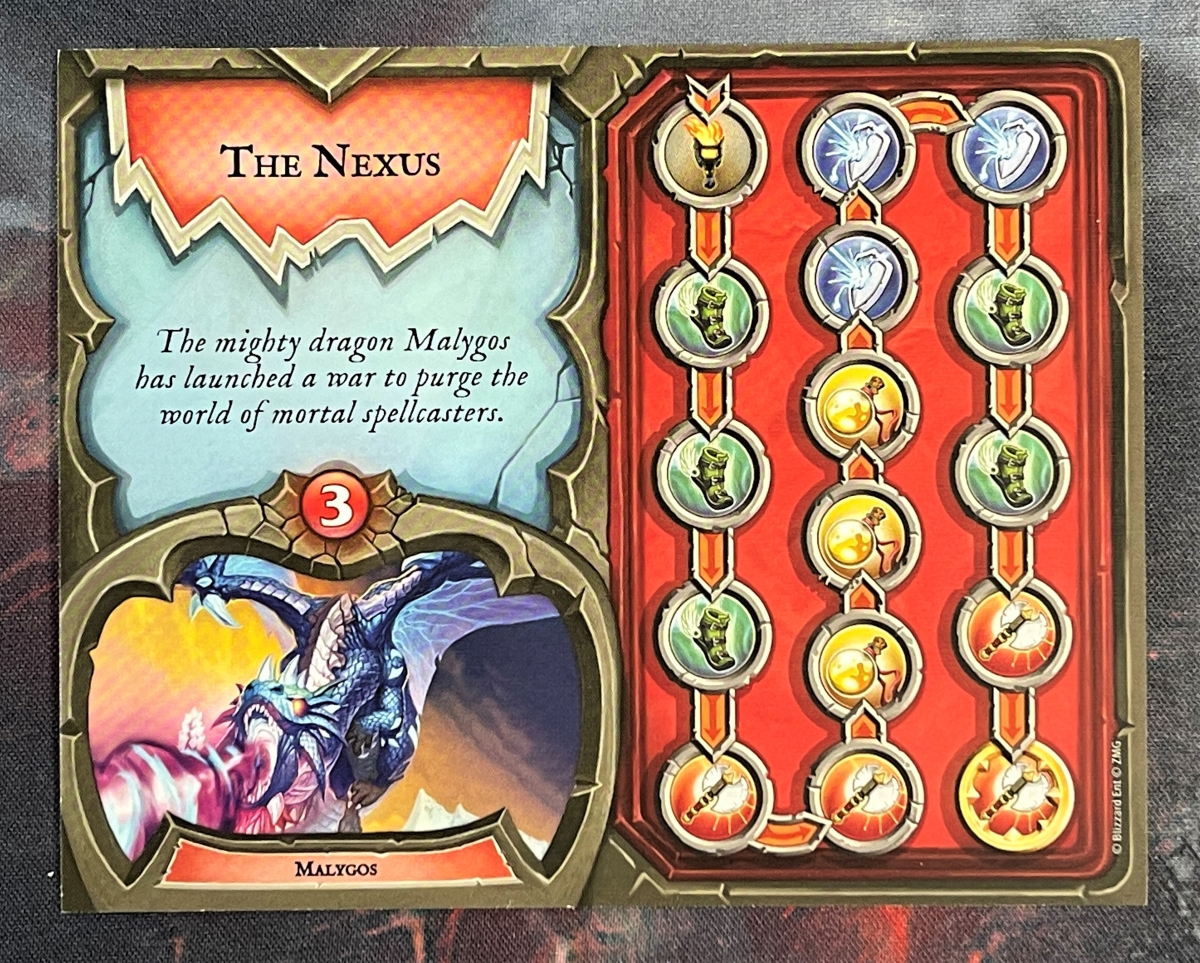
The Scourge cards, which function similarly to the Infection cards in Pandemic, have both a mini map and a zoomed-in image to make it quick and easy to place pieces on the game board.

How to Play World of Warcraft: Wrath of the Lich King – A Pandemic System Game
You can download a copy of the rulebook here.
The Goal
The goal of World of Warcraft: Wrath of the Lich King – A Pandemic System Game is to work together to complete all the quests and defeat the Lich King, before reaching the end of the Despair Track.

Setup
Place the board in the center of the table, with the Ghouls, Abominations, and Strongholds nearby. Place the Scourge and Despair markers on their respective tracks.

Place the Icecrown Citadel piece on its space on the board, with towers inserted. Place the Icecrown Citadel Quest Sheet facedown in its spot on the board.

Randomly place one Reward card facedown in each of the 3 Quest spaces. Then randomly take 1 Quest Sheet matching each of the 3 colored regions, and place them faceup in their respective spaces on top of the Reward cards. Place a Quest Marker token of the matching color, and place it on the city space on the board matching each Quest Sheet.

Shuffle the Scourge deck and place it facedown where indicated by the game board. Draw 1 Scourge card, and place 3 Ghouls on the matching space. Then, place the Lich King on the matching color Lich King space.
Draw another Scourge card, and place 3 Ghouls on the matching space.
Draw 3 more Scourge cards, and place 2 Ghouls on the matching space.
Draw 3 more Scourge cards, and place 1 Ghoul on the matching space.
Finally, draw 1 more Scourge card and place an Abomination on the matching space. Place the drawn Scourge cards faceup in the discard pile.
Each player chooses a hero, and takes the matching Hero Sheet and miniature. They place a slider on the health bar at the bottom of the sheet in the leftmost space on the bar. The miniature is placed on the character’s starting location, as indicated by the back of the Hero Sheet.

Each player is given a reference card, and then dealt 3 faceup Hero cards for a 2-3 player game, or 2 Hero cards for a 4-5 player game.
Finally, you build the Hero deck by dividing the deck up into a number of roughly evenly-sized piles based on how difficult you’d like your game to be. Place 1 Scourge Rises card onto each pile. Also take the indicated number of Stronghold cards, and place 1 onto each of the leftmost piles. Shuffle each pile individually, then stack them in order with the leftmost deck on top. Place the Hero deck in the area indicated by the board.

Gameplay
The player who has ventured furthest north takes the first turn.
On a player’s turn, they will always do the following 4 steps in order:
- Do 4 Actions
- Draw 2 Hero Cards
- Spawn Ghouls
- Activate Abominations
1. Do 4 Actions
On your turn, you may do up to 4 actions. You can do any of the actions multiple times; each time counts as one of the 4 actions. The actions are as follows:
Move
Move to an adjacent space, as indicated by the line between the spaces. Enemies do not affect movement.
Fight
If you are on the same space as an enemy, you may initiate a fight action to remove them. Roll both dice. Each fist symbol deals 1 damage to an enemy in your space. Ghouls take 1 damage to remove, Abominations take 3. After dealing hero damage, any remaining enemies deal damage back to the Hero. Each shield symbol blocks 1 damage. As a free action, you may also play any cards from your hand that can aid your fight. Those cards are discarded after use.
Note: when a Hero fights or does a Quest action in the same region as the Lich King, the Lich King adds 1 damage to that action.

Quest
While on one of the Quest spaces, you can try to progress and complete a quest. Roll both dice and count the fist symbols. Those will count as the number of spaces that you may move along the quest track. Additionally, each Hero on the quest space may contribute 1 hero card that matches the next space on the Quest track. These cards are not discarded. You can alternate between the symbols on the contributed cards and the successes shown on the dice to move the maximum number of spaces on the Quest Sheet.
After moving the Quest tracker, the active player will then take the damage shown in the red circle on the Quest Sheet. Any Shield symbols shown on the dice or from cards played will each block 1 damage. Then, carry out any special instructions shown on the Quest Sheet.
If a Progress marker reaches the end of its track, the Quest is completed. The active player removes the Quest Sheet, Quest marker, and Progress marker from the game, and adds the Reward card underneath to their hand. Once all 3 of the Quests are completed, Icecrown Citadel will unlock along with the Icecrown Citadel Quest. You’ll also flip over the base of the cardboard Icecrown Citadel, and move the Lich King miniature on top of it.

Rest
As long as you are not on a Quest space, you roll both dice. Heal damage equal to the number of Fist symbols shown. You will heal 1 additional damage if you rest at a Stronghold.
Flight Path
Move your hero directly to any space with a Stronghold. Strongholds get placed when you draw a Stronghold card in the 2nd phase.
During the action phase, you may also play any of your cards that have “free action” listed on them.

2. Draw 2 Hero Cards
Draw the top 2 cards of the Hero Deck. If one of the cards is a Stronghold card, immediately place a Stronghold on any space on the board, then remove that card from the game.
If one of the cards is a “The Scourge Rises” card, then resolve it as follows:
- Advance the Scourge marker 1 space to the right on its track.
- Draw the bottom card of the Scourge deck. Move the Lich King to that region’s Lich King space. Add ghouls to the corresponding space until there are 3 ghouls total there, then add 1 abomination to that space.
- Shuffle the Scourge discard pile, including the card just drawn, and place the shuffled cards facedown on the top of the Scourge deck. Remove that “The Scourge Rises” card from the game.
Note: There is a 7-card hand limit in play at all times. If you ever end up with more than 7 cards, you must discard or play a Reward card from your hand until you are back at 7 cards.
3. Spawn Ghouls
One at a time, flip over as many Scourge cards from the top of the Scourge deck as the current number shown on the Scourge track. Place 1 Ghoul on each matching space. If a space already has 3 Ghouls, then an overrun occurs. Discard all flipped over Scourge cards.
Overrun
Instead of placing a 4th Ghoul, advance the Despair marker 1 space. Then, place 1 Abomination on the overrun space.
4. Activate Abominations
One at a time, each Abomination on the board moves 1 space towards the closest hero, and then deals 1 damage to a Hero on its space. The current player chooses which way it moves if 2 heroes are equidistant, and also chooses which Hero is damaged if there are more than one in the Abomination’s space.
After a player finishes their turn, the next player in clockwise order starts theirs.
Miscellaneous
If you ever have to place a Ghoul or Abomination and the supply is empty, move the Despair marker once for each enemy you could not place. If you ever need to draw a Hero card and the Hero deck is empty, move the Despair marker once for each card you could not draw.
If a hero is ever reduced to 0 health:
- Discard all cards from your hand.
- Advance the Despair marker twice.
- Place your Hero on their starting space, at full health.
Single Player Mode
There is a simple single player mode included, where the player controls 3 Heroes, but all 3 Heroes share a single hand of cards. A Gauntlet token is included in the game, to help keep track of which Hero’s turn it is.
Game End
If the players make it to the last space on the Icecrown Citadel Quest Sheet, they have defeated the Lich King and won the game. If the Despair marker ever reaches the end of the Despair track, then the players lose.
World of Warcraft: Wrath of the Lich King – A Pandemic System Game is GeekDad Approved!
Why You Should Play World of Warcraft: Wrath of the Lich King – A Pandemic System Game
The original Pandemic, designed by Matt Leacock, was originally released in 2008. World of Warcraft, the Blizzard Entertainment MMO, first went online in 2004. So you wouldn’t think it an obvious fit to put a 13-year old board game together with a 17-year old video game. Yet, both Pandemic and World of Warcraft have enduring popularity.
Pandemic has spawned multiple expansions and variations. You can play a dice game with Pandemic: The Cure. You can fight Lovecraftian monsters and cultists in Pandemic: Reign of Cthulhu. You can play an evolving game and storyline in the three different seasons of Pandemic Legacy. And World of Warcraft has had eight major expansions since launch, including 2008’s Wrath of the Lich King. Yes, Wrath was released the same year that the first Pandemic board game hit store shelves.
World of Warcraft: Wrath of the Lich King – a Pandemic System Game is not just the original Pandemic with a new coat of paint. Instead, it takes the key mechanics of Pandemic, and modifies the gameplay to create an experience that is evocative of its predecessor but that meshes perfectly with World of Warcraft. I’m not sure if it was coincidence or not that this particular World of Warcraft happens to share the same release year as Pandemic, but Wrath of the Lich King provides an ideal setting for a Pandemic system game. In that expansion, the Scourge are attacking Azeroth, and the combined heroes of the Alliance and the Horde must venture to the frozen Northrend to ultimately enter Icecrown Citadel and put an end to the Lich King.

A Pandemic game is, at its heart, about removing invading organisms. In the original, those organisms are diseases. In needing to remove an invading army rather than disease, World of Warcraft: Wrath of the Lich King – a Pandemic System Game reminds me most of another game in the same series, Pandemic: Fall of Rome. But both are very different games. On a superficial level, World of Warcraft: Wrath of the Lich King – a Pandemic System Game uses miniatures for its army, instead of the colored cubes of Fall of Rome. Pandemic: Fall of Rome also has one of the more complicated rulesets of all the Pandemic games, while World of Warcraft: Wrath of the Lich King – a Pandemic System Game is a much more straightforward and accessible game, in keeping with the World of Warcraft theme. But don’t confuse straightforward with easy. There are multiple ways to adjust the difficulty in this game, and you can find yourself just as challenged as in any Pandemic game. But as that difficulty is scalable, you can easily adjust it to the tastes of your particular gaming group.
And how you face the Scourge army is executed in a way utterly befitting World of Warcraft. Gone are the colored player cards of the original Pandemic, which you had to collect as sets and turn in to cure a disease. Instead, you’re now undertaking quests. And even though you will be using Hero cards to help complete these quests, you won’t need to collect and trade them with other players like you would with the Pandemic cards. Indeed, you’ll find yourself often using the cards during combat, or to move farther across the board. A good strategic move is to use a Defend card to help progress a Quest marker(which as a reminder doesn’t make you discard the card), and then spend that same card as a free action to block the damage you’d take from progressing the quest.
The combat system is simple, yet is a lot of fun and adds to the World of Warcraft flavor. It certainly helps that there are no “bad” sides to the two dice. Every result is either a fist, a shield, or combinations thereof. So, if you only rolled shields during a fight, you wouldn’t do any damage, but conversely you’d take little to none in return. And, as mentioned before, you can also spend cards during combat to boost your damage or block incoming hits.

Heroes have fun and characterful abilities. For example, Thrall has a chain lighting attack that, if positioned well, can potentially remove a LOT of Ghouls from the board with 1 action. But he’s not just a beast in combat; his “I Am the Warchief” passive ability is also very useful. And, if you’ve played World of Warcraft, you know that both of his abilities fit Thrall’s character well. The combination of the Heroes’ abilities and the combat system really does make you feel like a mighty warrior or mage, as opposed to, say, a researcher or a dispatcher.
I found when playing World of Warcraft: Wrath of the Lich King – A Pandemic System Game that we didn’t have to coordinate our actions quite as efficiently as you do in a regular game of Pandemic. Not that you can just run around yelling, “Leeroy Jenkins!” either. Cooperation is still required amongst players, but the game is a bit more forgiving than some other versions of Pandemic…at least at the lower difficulty levels. You feel much more like you’re on an adventure to defeat a great evil, than trying to solve the puzzle of how to most efficiently control the spread of disease.
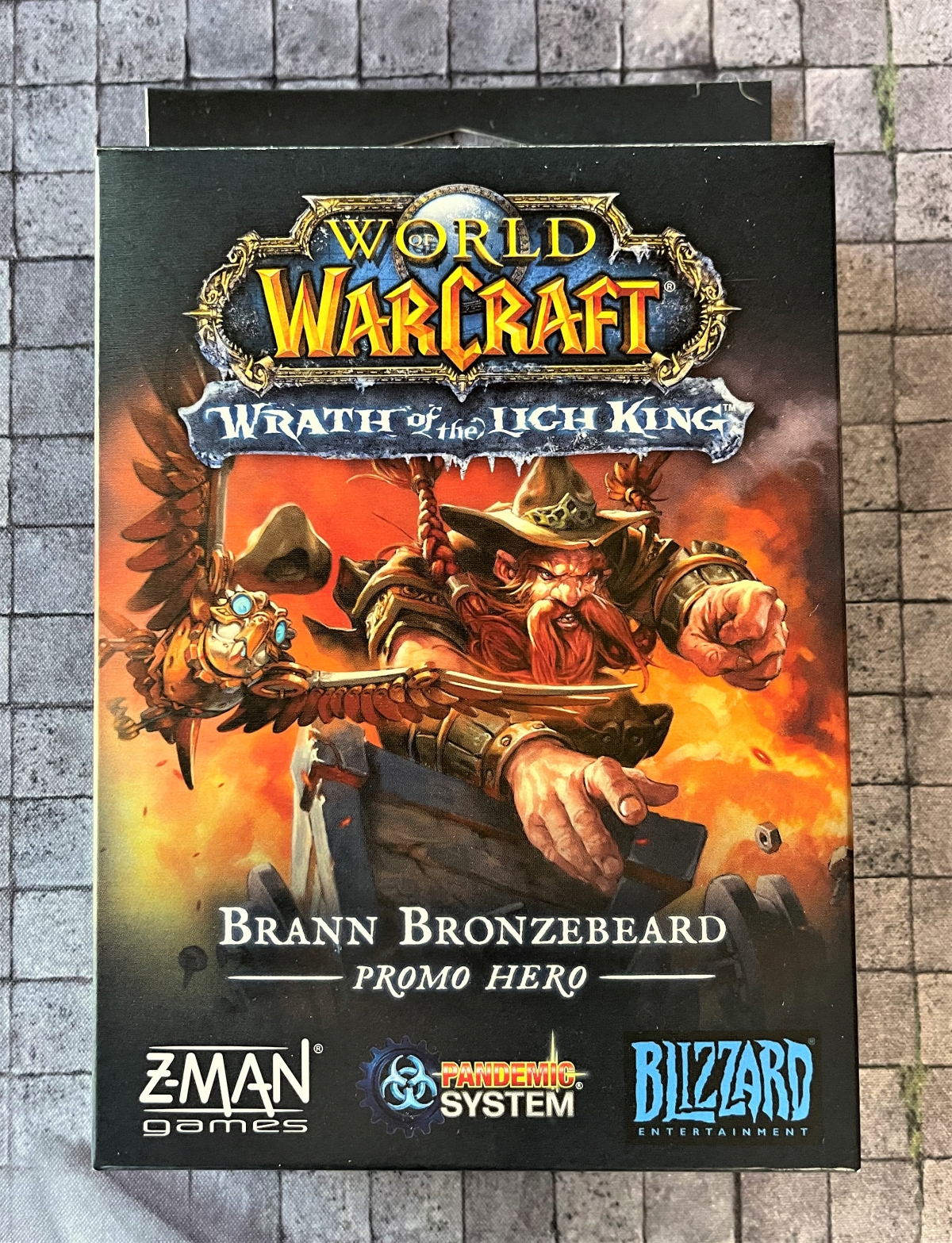
It’s also worth noting that Z-Man games included a promo character when they sent the game. The Brann Bronzebeard box came with a Hero sheet and miniature, and can be used just like any of the other Heroes in the game. This could point towards plans for future expandability to World of Warcraft: Wrath of the Lich King – A Pandemic System Game. Adding in new Heroes and different Quests would be an easy task to accomplish with the game, and would definitely provide more replayability. Not that there isn’t already a lot of replayability inside the box. With 7 Heroes to choose from, 3 different Quests per region, and multiple difficulty settings, there’s plenty of game to last you many a game night of questing in Northrend.
I found World of Warcraft: Wrath of the Lich King – A Pandemic System Game to be very enjoyable, and a refreshing change of pace from the original Pandemic. It still shares some of the DNA of its predecessors, but is executed in a way that fits the theme to a tee. If you’re a fan of World of Warcraft, then picking this one up is a no-brainer. And even if you’ve never played the MMO before, World of Warcraft: Wrath of the Lich King – A Pandemic System Game is an engaging and entertaining fantasy-themed cooperative board game that will see a lot of table time.
Click here to see all our tabletop game reviews.
![]() To subscribe to GeekDad’s tabletop gaming coverage, please copy this link and add it to your RSS reader.
To subscribe to GeekDad’s tabletop gaming coverage, please copy this link and add it to your RSS reader.
Disclosure: GeekDad received a copy of this game for review purposes.
